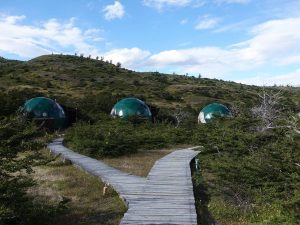
by Jason Bowles | Feb 3, 2018 | Jason, South America
A few photos for now, more to follow from Torres Del Paine.

Ecocamp, Torres Del Paine.
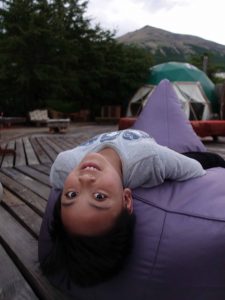
Francis, our new friend from Tuscon.
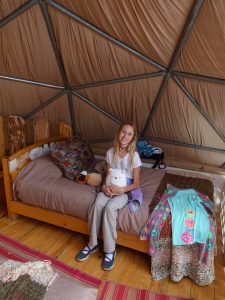
The loft in our dome.
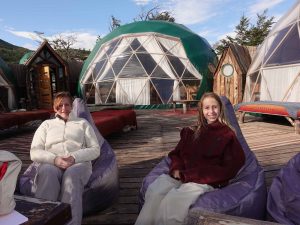
Relaxing by the community domes with a great view of the towers.
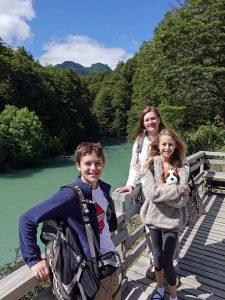
by Jason Bowles | Jan 24, 2018 | Jason, South America
Crossing the Andes from Chile to Argentina was originally a commercial endeavor, bringing Chilean goods closer to international markets. The route we followed has been in use since the late Nineteenth Century but foundered after the opening of the Panama Canal just over a hundred years ago. The route survives though, as an enterprising individual recognized its potential and kept the route alive transporting tourists instead of Chilean goods.
We started our journey in Bariloche, Argentina. It was only a short walk from the apartment we had rented to the Hotel Edelweiss, where we caught our first bus. We stowed our packs in the belly of a Greyhound-like bus and began the first leg of our journey along Lake Nahuel Huapi to Puerto Pañuelo, where we boarded our first ferry. For the next hour, we sailed west through a narrow, glacier-carved arm of the same lake to Puerto Blest. Here we found a newly renovated hotel accessible only by this ferry, one of two possible places to break up what otherwise is a 12-hour journey. The hotel was built on a small peninsula separating the crystal-clear waters of the lake from the colored water of the lower Frias river where it discharges its turquoise sediment into Nahuel Huapi. Here, we boarded smaller buses that transported us along 3 kilometers of dirt road to Frias Lake which was colored just like the river.

Crossing Lago Frias
Frias is a much smaller lake, and the second ferry lasted only 30 minutes, bringing us to the last outpost on the Argentine side. We had to wait for the border police (who arrived on the same boat we did!) to get organized before they could stamp our passports and process us out of their country.
The next leg of the journey was the most interesting. The road leading out of Puerto Frias across the frontier was a steep, single lane that switched back-and-forth up from the lake to cross the border between Argentina and Chile. The border in the southern parts of these countries was created by connecting the highest peaks in the Andes. Where we crossed, this was a volcano nearly 11,000 feet high named Tronador. After we crossed the border—marked with a sign and a simple log portal across the road—we had a spectacular view of the peak and the glaciers advancing down from the summit. At this point in the journey, we were in old 4-wheel-drive buses that occasionally had to be outfitted with chains to make the journey.
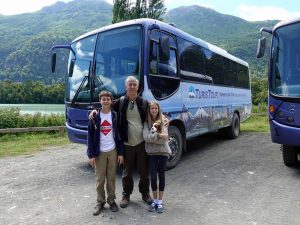
4×4 bus to take us across the border.
We bumped along this road, descending from the border down into Chile. The road transitioned from the steep mountain road to a pastoral river valley with a few ranches before we arrived at a small “town” called Peulla. A large hotel—Natura—was where we would spend the night, but only after clearing Chilean immigration and customs, not a very efficient process as the 50 of us making the crossing tried to locate our luggage and open every one of our bags for the few customs agents assembled in what amounted to a small plywood shed. After clearing this hurdle, it took some time to sort out the next bit of confusion as company organizing the crossing had only booked one room with three single beds for our family of four.
While we settled in for the evening, the majority of those who started with us boarded the final ferry to cross Lake Todos Los Santos. Peulla is located at the eastern end of the lake where the glacial Peulla river and the volcanic Black river join the lake. In addition, a smaller stream plunged into the lake from the cliffs near the dock on the lake. This stop afforded us a leisure morning and a midday 4×4 tour of the valley, crossing through the Peulla river and boating along the Black River. The highlight for the kids was visiting a nearby ranch that had pigs, goats, llamas, and alpacas.
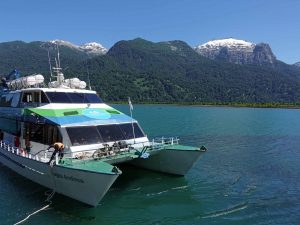
Ferry on Lago Todos Los Santos.
Later that afternoon, we joined the group making the crossing from Argentina that morning, boarded the final ferry and motored for two hours the length of Todos Los Santos. Midway through the journey we rounded a bend and saw our destination, although we did not yet know it. What we saw was the perfect snow-capped cone of the volcano, Orsorno. For the next hour, we watched it grow larger until we finally reached Petrohué on the eastern base of the volcano. Here a bus took us the last hour to Puerto Varas, driving between Osorno to the north and another volcano, Calbuco, to the south, along the shore of Lake Llanquihue. Calbuco last erupted in 2015. The mushroom cloud of the initial explosion was visible over 100 miles away, and for over a month ash from the eruption covered the surrounding towns. All told, over 4 meters of ash had to be cleared to reopen the road.
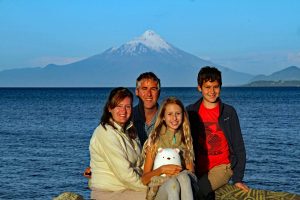
Volcan Orsono
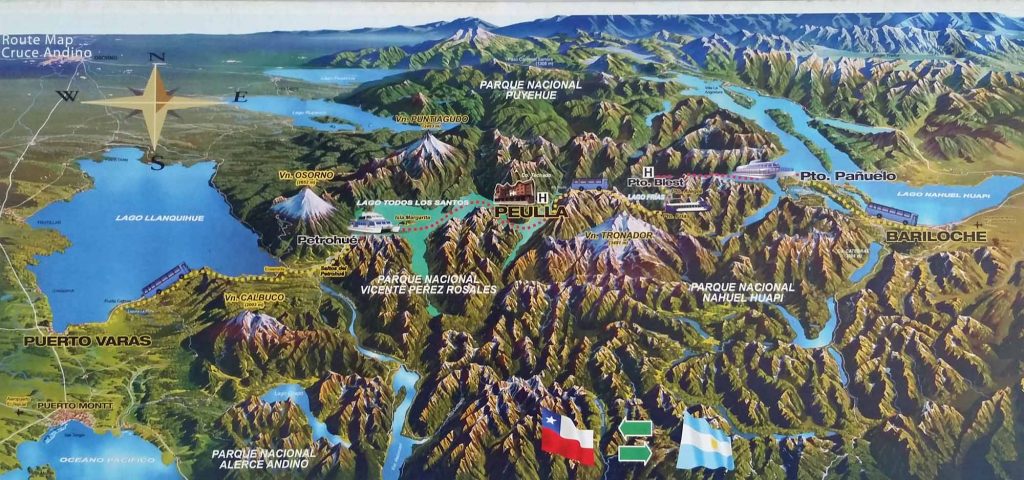
Our route from Bariloche, Argentina, to Puerto Varas, Chile.
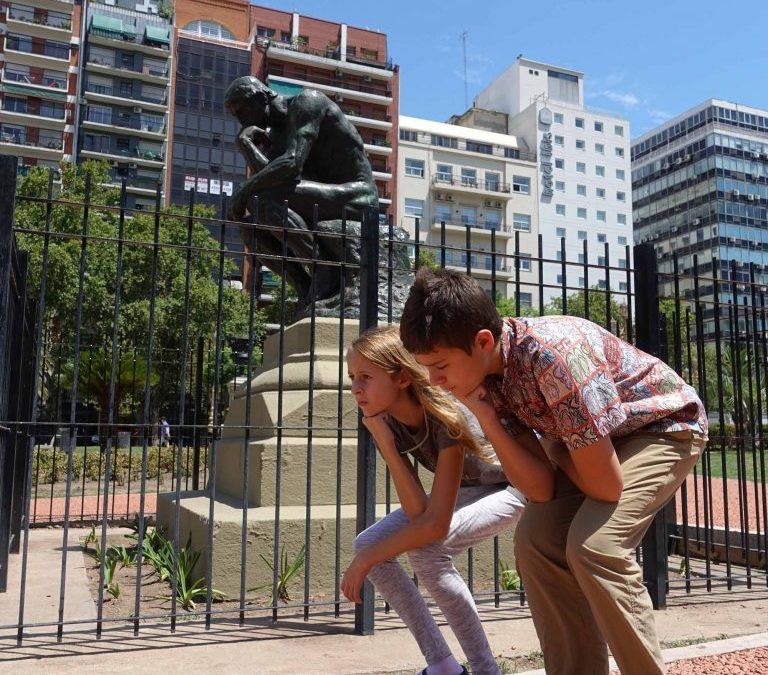
by Jason Bowles | Jan 17, 2018 | Jason, South America
It took some explaining to appreciate the moniker “Paris of the south.” In general, big cities can be rather generic. Paris makes my short list of exceptions, though. I was excited to visit, and hoping that BA would join Paris, Istanbul, Bangkok, New York, and the few other big cities that have enough unique character to make them stand out.
At first, it seemed a very poor comparison. Leaving the Aeroparque Jorge Newbery, we took a taxi into town. The domestic airport sits on the bank of Buenos Aires’ “river”, the Rio de la Plata, which isn’t really a river. Over 200 kilometers wide, the Rio de la Plata might be better categorized as an estuary (or possibly a gulf) that happens to meet the confluence of the Parana and Uruguay rivers. There is a fair amount of commercial activity along the Rio, and looking north all you see is the horizon; Uruguay is lost in the distance. Not nearly as charming as the banks of the Seine.
When we reached our apartment building in Recoleta, the streets started to look a bit more continental. Closer to the city center, wide avenues and European architecture were even more common. We also visited a city park with a large Rose Garden designed by a French landscape architect that did have a Parisienne feel. When pointed out, the similarities are there—certainly more so than any of the other Latin American capitals I have visited—but I certainly would not have made the comparison myself.
OK, so it’s not Paris. What is there to see and do in Buenos Aires? The most popular tourist attraction is the Recoleta Cemetery, the highest rent district in the city. In a relatively small space (about a city block), the city’s elite have been building monuments to themselves for centuries. Within and under these monuments are the crypts containing generations of their progeny, as many as six levels down. Most of the names were lost on us, but we did visit the tombs of Domingo Sarmiento and Eva Peron. The kids were not impressed.
The Rose Garden was interesting as it contained monuments to the revolutionary leaders that helped liberate the Americas from their European masters: Jose de San Martin (the liberator of Argentina), Simon Bolivar (who liberated the northern half of the continent), Jose Marti (who we learned about when visiting Cuba not long ago), and even George Washington. No monument to Che Guevara, but we did visit the University where he studied medicine.
Two highlights from BA: a Tango show, and discovering closed-door dining. Certainly, one of the Tango-capitals of the world, we had to go to a Tango show while in Buenos Aires. We were a little apprehensive as the show was not well attended (there were more people on stage than in the audience), but the show was fantastic! The dancing and live music were outstanding and included dances with drums, whips, and the Argentine equivalent of Hawaiian poi balls. After the show, we learned that the accordion player, Carlos Buono, was a virtuoso and was well-known around the world.
Closed-door dining was another highlight. Apparently, this exists around the world, but we had never heard of it before. We read about Casa Saltshaker in Lonely Planet and it came highly recommended. The restaurant is in the home of the proprietors, and only after you secure a reservation do you learn where that is. We arrived at 9 pm and had drinks with 8 others before joining them around the dining table in the chef’s home. We enjoyed great food throughout our stay in BA, but this 5-course meal was, without question, the best. The experience, also, was quite unique, and one that we look forward to repeating.

One of only 3 copies of Rodin’s The Thinker cast from the original mold.

Pope Francis used to give mass here before he was elevated.
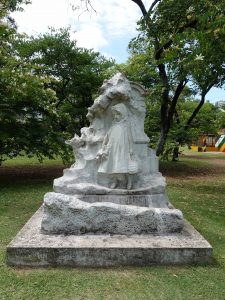
The only statue of Little Red Riding Hood.
by Jason Bowles | Jan 14, 2018 | Jason, South America
Six weeks in South America–where to start? Patagonia in general and Torres del Paine, in particular, have been calling for decades. Finally, we are going to make it happen. Arranging enough time off of work and pulling the kids out of school took a while to organize, but finally, we are on our way. Obviously, we can’t see everything, so how to decide? Fortunately, this isn’t our first time in South America. Machu Picchu, Titicaca, Galapagos, Amazon . . . We have seen a few of the highlights already. Iguassu seemed like a logical place for us to start. Generally regarded as one of the seven natural wonders of the world, Iguassu falls has also been on my “must see” list. As the falls straddle the border of Brazil and Argentina, it also seemed logical to start in Brazil and see both sides as we worked our way south into Argentina. As it turns out, this was a great way to go.
There is only one hotel within the park on each side of the border, and both are very convenient to the falls. We started in Brazil, staying at the Belmond Hotel Das Cataratas–fantastic! Beautiful building, great facilities, friendly staff. Couldn’t ask for a better way to start a vacation. The hotel only has a partial view of some of the falls, but right across the street is the trail along the river and we had free access to the falls. Early morning walks with a handful of others was a pleasant treat. Within a few hours, bus-loads of tourists were arriving from the park gate, 10 kilometers away.
The trail on the Brazilian side offers spectacular panoramic views of the falls, the majority of which are on the Argentine side of the Iguassu river. An elevated boardwalk takes you out over the river in the midportion of the Devil’s Throat, the largest of over 350 falls that form as the Iguassu river plunges for nearly 2 kilometers. From this platform you hear and feel the roar of the cascades, you are quickly drenched from the spray that blasts out from the bottom of the fall and rises almost 500 feet into the air. From the Brazilian side, you can see walkways along the tops of some of the falls in Argentina. It seemed that walking along the top of a waterfall, even one as impressive a those at Iguassu, couldn’t possibly compare to the view offered from the Brazilian side.
Traveling to the other side, though, it doesn’t take long to realize that to truly see the falls you need to see both sides. Walking the several kilometers of elevated walkways on the Argentine side is a totally different experience. You don’t appreciate from the Brazilian side that the Argentine trails are in the river. Just above the falls, the Iguassu river is nearly a mile wide so it is quite a trek out on the walkway that leads to the Garganta del Diablo–the Devil’s Throat. The walkway ends at a perch looking down into the largest fall at Iguassu. Even if it wouldn’t have been raining we still would have been drenched. The other two trail circuits were also spectacular and offered a unique perspective from the top and midportions of the Argentine falls. Very different, but both offer unique opportunities to see and enjoy what has to be the most spectacular waterfall in the world.
On the Argentine side, what used to be the Sheraton has recently changed names and is now the Melia Iguazu. The hotel itself is not nearly as nice as the Belmond, but our rooms had great views of the falls. It also offered easy access to the trail network around the falls and saved us traveling back-and-forth across the border to see the falls, and later to catch our flight from the Argentine side on to Buenos Aires.

by Jason Bowles | Dec 4, 2017 | Indonesia, Jason
Finally. We made it! After scrambling to find a flight out of Darwin, passing through Singapore, one day in Jakarta, two in Makassar, we finally caught a break. The uncertainty surrounding the volcanic eruption on Bali prompted Wakatobi to change their charter flight from Denpasar (Bali) to Makassar. Instead of a local flight to either Kendari or Wangi-Wangi followed by several hours of bus and boat travel, we were able to fly from Makassar to Tomia (one of the four main Tukangbesi Islands that give Wakatobi—Wangi-Wangi, Kaledupa, Tomia, Binongko–its name). From Tomia, it was only a short ride from the airport to the dock where two dive boats were waiting to take us the last 20 minutes to the small neighboring island where the resort is found.

Nothing says “Welcome” like a personalized, hand-carved mahogany placard over the door of your villa.
It wasn’t hard to settle into our 2-bedroom villa with a private pool overlooking the ocean (believe me, it’s better than it sounds)!

I think we have found paradise!
After a nice lunch, Alex, Maile and I met Yono–our private dive guide–for a briefing. Twenty minutes later we were in the water, diving Wakatobi’s House Reef. It was only the three of us. Unfortunately, by the time we arrived Stacy was suffering from food poisoning. Since we never made it there we can’t rightly call it Bali Belly; let’s just say it was Makassar’s Revenge. Hopefully, a good night’s sleep (and a couple of Cipro) will take care of it.
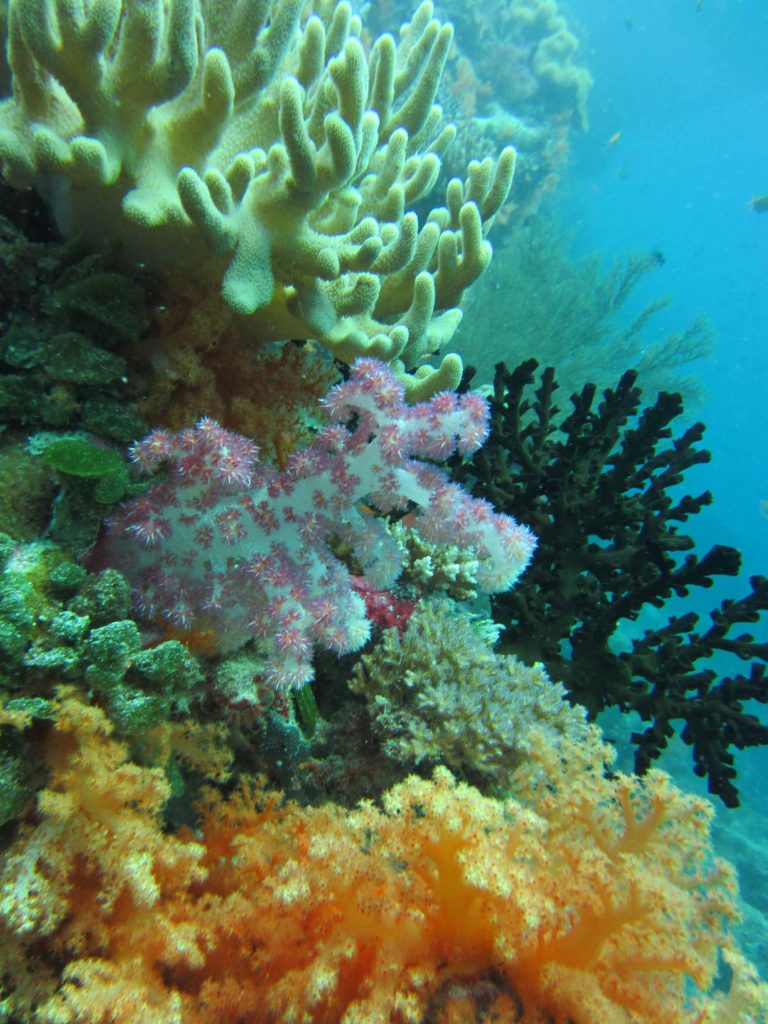
House Reef, Wakatobi























